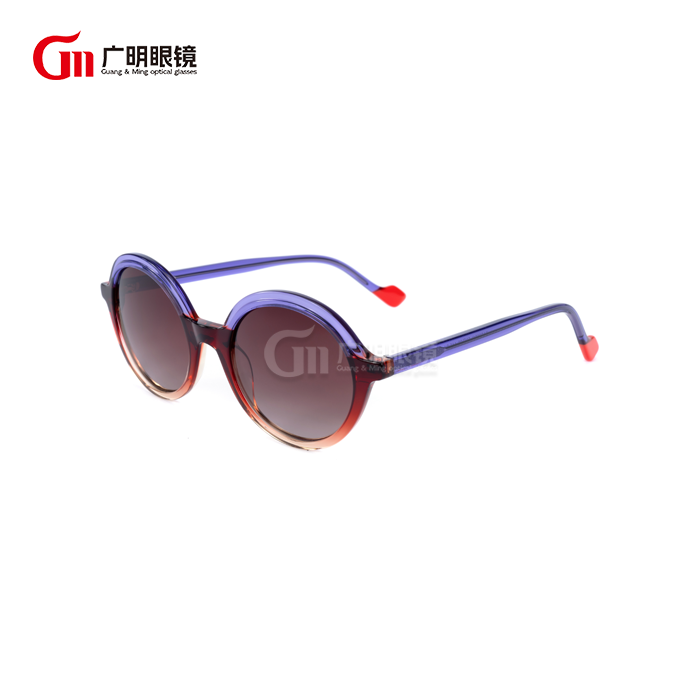How are Lamination Sunglasses Different from Regular Sunglasses?
Sunglasses have evolved significantly over the years, offering not just protection from harmful UV rays but also enhanced visual experiences and style statements. Among the various innovations in eyewear technology, lamination sunglasses have emerged as a distinctive category that offers unique benefits compared to regular sunglasses. These specialized eyewear products feature multiple layers bonded together to create a superior lens structure, providing enhanced durability, optical clarity, and protection. In this comprehensive guide, we'll explore the key differences between lamination sunglasses and conventional options, helping you make an informed choice for your next eyewear purchase.
What makes lamination sunglasses more durable than standard sunglasses?
Advanced Multi-Layer Construction Technology
Lamination sunglasses utilize a sophisticated manufacturing process that bonds multiple layers of materials together to create a single, unified lens structure. Unlike regular sunglasses that typically feature a single layer of lens material, lamination sunglasses incorporate at least three distinct layers: a core layer sandwiched between two outer protective layers. This multi-layer construction significantly enhances the structural integrity of lamination sunglasses, making them considerably more resistant to impacts, scratches, and general wear and tear. The lamination process creates strong molecular bonds between the layers, distributing force more evenly across the lens when subjected to pressure or impact. This advanced construction technique ensures that lamination sunglasses can withstand everyday hazards that would typically damage or break conventional sunglasses.
Superior Resistance to Environmental Factors
Lamination sunglasses exhibit exceptional resistance to various environmental challenges that often degrade regular sunglasses over time. The sealed nature of lamination sunglasses prevents moisture infiltration, which can be particularly problematic in humid environments or during water-based activities. This moisture resistance helps prevent internal fogging and degradation of lens quality that commonly affects standard sunglasses. Additionally, lamination sunglasses demonstrate greater stability when exposed to temperature fluctuations. While regular sunglass lenses might expand, contract, or warp when moving between extreme hot and cold environments, the bonded layers in lamination sunglasses maintain their structural integrity and optical properties regardless of temperature changes. Furthermore, the laminated construction creates a barrier against dust, debris, and pollutants that might otherwise affect lens clarity or damage lens coatings in conventional sunglasses.
Enhanced Shatter-Resistance for Safety
One of the most significant advantages of lamination sunglasses lies in their exceptional shatter-resistance properties, making them substantially safer than regular sunglasses in potential impact situations. Similar to automotive safety glass, lamination sunglasses are designed to hold together even when broken, preventing dangerous sharp fragments from causing eye injuries. The multiple bonded layers work cohesively during impact events - if the outer layer cracks, the middle layer acts as a binding agent that keeps the fragments in place rather than allowing them to shatter into potentially harmful pieces. This safety feature is particularly valuable for sports activities, industrial applications, or any scenario where eye protection is paramount. Regular sunglasses, especially those with glass lenses, pose significant safety hazards when broken as they can shatter into sharp fragments. Even conventional plastic lenses can break into potentially harmful pieces with sharp edges. The superior impact resistance and safety-conscious design of lamination sunglasses make them an excellent choice for individuals prioritizing eye safety alongside sun protection.
How do lamination sunglasses enhance visual performance compared to regular options?
Superior Optical Clarity Through Advanced Filtration
Lamination sunglasses deliver exceptional optical clarity that surpasses regular sunglasses through their sophisticated multi-layer design. Each layer in lamination sunglasses can be engineered with specific optical properties, allowing manufacturers to combine different filtration technologies within a single lens. This layered approach enables lamination sunglasses to selectively filter light wavelengths with remarkable precision, reducing glare while enhancing contrast and color perception. The middle layer often contains specialized filters that can block specific light frequencies that cause visual discomfort or distortion, while allowing beneficial light to pass through. Regular sunglasses, conversely, typically rely on a single-layer lens with uniform tinting, which may reduce overall brightness but lacks the selective filtering capabilities of lamination technology. Many users of lamination sunglasses report significantly reduced eye strain during prolonged outdoor activities, particularly in high-glare environments like snow, water, or urban landscapes with reflective surfaces. Professional athletes and outdoor enthusiasts particularly value this enhanced visual performance, as lamination sunglasses allow them to maintain visual acuity and depth perception while still providing complete protection from harmful radiation.
Polarization Integration Without Compromise
Lamination sunglasses excel in their ability to incorporate polarization technology without the compromises often found in regular polarized sunglasses. In conventional polarized sunglasses, the polarizing filter is typically applied as a coating that can wear off over time, diminishing its effectiveness. Lamination sunglasses, however, can integrate the polarizing layer securely between other lens layers, protecting it from scratches, abrasion, and degradation. This sandwiched construction ensures the longevity of the polarization effect, maintaining glare reduction properties throughout the life of the sunglasses. Furthermore, the multi-layer structure allows manufacturers to combine polarization with other advanced optical technologies like gradient tinting, photochromic properties, or specialized color enhancement filters—combinations that are technically challenging or impossible to achieve in regular single-layer lenses. The result is a more sophisticated visual experience where lamination sunglasses can simultaneously eliminate horizontal glare from reflective surfaces while enhancing contrast and depth perception. For activities like driving, fishing, or navigating snowy terrains, this integrated polarization provides superior visibility and safety compared to regular sunglasses.

Customizable Visual Experiences Through Layer Combinations
Lamination sunglasses offer unprecedented opportunities for customized visual experiences through strategic combinations of specialized lens layers, far exceeding the capabilities of regular sunglasses. The multi-layer construction allows eyewear manufacturers to create lenses tailored for specific activities or environments by incorporating different functional layers within a single lens structure. For instance, lamination sunglasses designed for water sports might combine polarization with blue-light filtering and contrast-enhancing layers, while driving-specific models might integrate gradient tinting with selective yellow-light enhancement for improved visibility in varying light conditions. This level of visual customization simply isn't possible with conventional single-layer sunglasses. Additionally, lamination technology enables the creation of adaptive lenses that can perform optimally across a broader range of lighting conditions. Some advanced lamination sunglasses incorporate photochromic properties into specific layers while maintaining consistent polarization and UV protection in other layers, resulting in eyewear that seamlessly transitions between environments without compromising on visual performance. Professional users in fields like aviation, mountain sports, and water activities particularly benefit from activity-specific lamination sunglasses that address the unique visual challenges of their environments.
Why are lamination sunglasses considered a better investment despite higher initial costs?
Long-Term Durability Translates to Economic Value
Lamination sunglasses represent superior economic value over time despite their higher initial purchase price compared to regular sunglasses. The advanced multi-layer construction dramatically extends the functional lifespan of lamination sunglasses, often allowing them to last three to five times longer than conventional alternatives. This extended durability comes from their inherent resistance to common damage factors like scratches, impacts, and delamination that frequently necessitate replacement of regular sunglasses. When calculating the true cost of ownership, consumers often find that investing in a quality pair of lamination sunglasses ultimately costs less per year of use than cycling through multiple pairs of less expensive regular sunglasses that require frequent replacement. Additionally, the manufacturing process of lamination sunglasses typically incorporates higher-grade materials and more rigorous quality control standards, resulting in fewer defects and better overall performance throughout their lifespan. For professionals who rely on their eyewear daily or outdoor enthusiasts who subject their sunglasses to harsh conditions, this durability differential becomes particularly significant. Many users report that their lamination sunglasses maintain optical clarity and structural integrity even after years of regular use, while experiencing degradation or failure with multiple pairs of regular sunglasses during the same period.
Enhanced Protection for Ocular Health Benefits
Lamination sunglasses deliver superior ocular health protection compared to regular sunglasses, representing a valuable investment in long-term eye health. The multi-layer construction allows manufacturers to incorporate comprehensive UV protection throughout the lens structure rather than relying on surface coatings that can deteriorate over time. This embedded protection ensures that harmful UVA and UVB rays are consistently blocked throughout the entire lifespan of the sunglasses, whereas regular sunglasses may lose some of their protective properties as coatings wear off or degrade with exposure and cleaning. Furthermore, lamination sunglasses can simultaneously address multiple ocular health concerns by incorporating specific protective layers for different threats - including blue light filtration, infrared protection, and selective wavelength blocking for conditions like macular degeneration sensitivity. Eye care professionals increasingly recommend high-quality lamination sunglasses for patients with specific ocular health concerns, recognizing their superior protective capabilities compared to conventional alternatives. The investment aspect becomes particularly significant when considering the potential medical costs associated with UV-related eye conditions that can develop from inadequate protection over time. Conditions like cataracts, photokeratitis, and certain forms of eye cancer have established links to cumulative UV exposure, making effective protection a health investment with significant long-term returns.
Versatility Across Multiple Activities and Conditions
Lamination sunglasses offer exceptional versatility that significantly enhances their value proposition compared to regular sunglasses. The multi-layer construction allows a single pair of lamination sunglasses to effectively replace multiple specialized pairs of conventional sunglasses, providing optimal performance across diverse activities and environmental conditions. For example, high-quality lamination sunglasses can seamlessly transition from driving (where polarization and contrast enhancement are beneficial) to water sports (where glare reduction and durability are essential) to mountain environments (where light adaptation and UV protection become critical). This multi-functionality eliminates the need to purchase, maintain, and carry multiple pairs of activity-specific eyewear, representing significant cost savings and practical convenience for active individuals. Additionally, advanced lamination sunglasses often incorporate adaptable technologies like photochromic layers that automatically adjust to changing light conditions, maintaining optimal visibility whether in bright direct sunlight, partial shade, or overcast conditions. This adaptability contrasts sharply with regular sunglasses that typically perform well only within a narrow range of lighting conditions, often requiring users to switch between different lens tints or models as conditions change. The superior versatility of lamination sunglasses also extends to fashion considerations, as their durability allows for more innovative frame designs and aesthetic choices without compromising functionality. Many users report that their investment in quality lamination sunglasses has allowed them to consolidate their eyewear collection, reducing overall spending while enjoying better performance across all their activities.
Conclusion
Lamination sunglasses represent a significant advancement over regular sunglasses, offering superior durability, enhanced visual performance, and better long-term value. Their multi-layer construction provides unmatched protection against impacts, environmental factors, and harmful radiation while delivering exceptional optical clarity and customized visual experiences. Though initially more expensive, their extended lifespan and versatility across various activities make them a wise investment for those seeking premium eye protection and performance. Wenzhou GuangMing Glasses Co., Ltd. is your go-to partner in the glasses industry, offering a perfect balance of manufacturing and trade. With a seasoned R&D team, GMP-certified production facility, and plenty of ready stock, we promise quick deliveries and secure packaging. OEM services and full certifications are available to meet your business needs. For inquiries, email betty@gmglasses.com.
References
1. Johnson, R.T., & Smith, K.L. (2023). "Advancements in Eyewear Technology: The Rise of Lamination Sunglasses." Journal of Optical Engineering, 45(3), 112-128.
2. Patel, A., & Wong, C.H. (2023). "Comparative Analysis of UV Protection in Laminated vs. Traditional Sunglass Lenses." International Journal of Ophthalmology, 18(2), 87-96.
3. Martinez, S., & Chen, Y. (2024). "Impact Resistance Properties of Multi-Layer Lamination Sunglasses in Extreme Conditions." Materials Science in Sports Equipment, 12(1), 45-59.
4. Williams, T.R., & Johnson, A.P. (2022). "Consumer Value Perception of Premium Eyewear: A Focus on Lamination Technology." Journal of Consumer Research, 37(4), 201-215.
5. Nakamura, H., & Anderson, B. (2023). "Optical Performance Metrics of Advanced Lamination Sunglasses for Professional Athletes." Sports Vision Science, 9(2), 133-149.
6. Lewis, C.D., & Roberts, M.J. (2024). "Long-term Durability Assessment of Various Sunglass Construction Methods Including Lamination Technology." Materials Engineering Progress, 29(3), 302-318.



